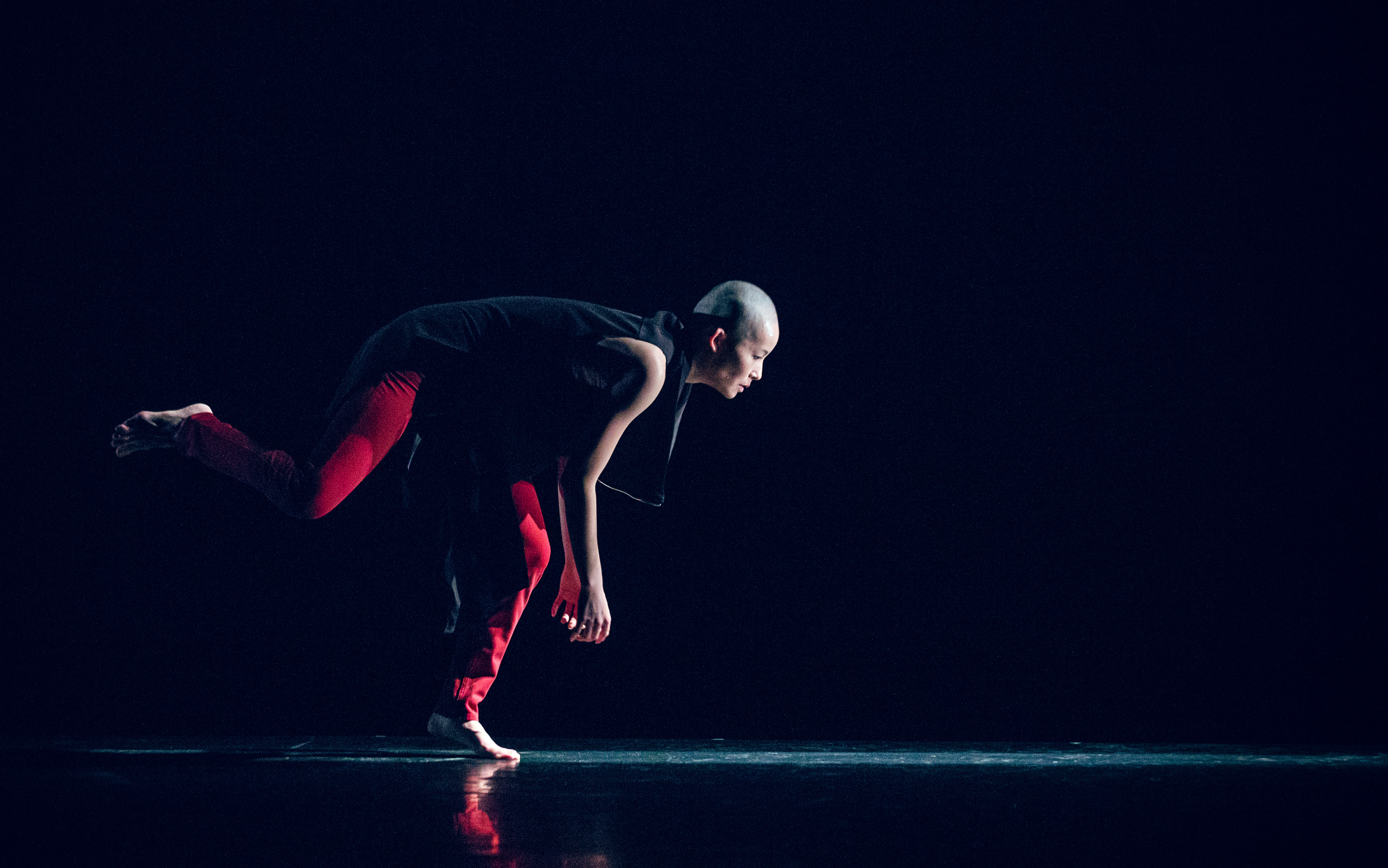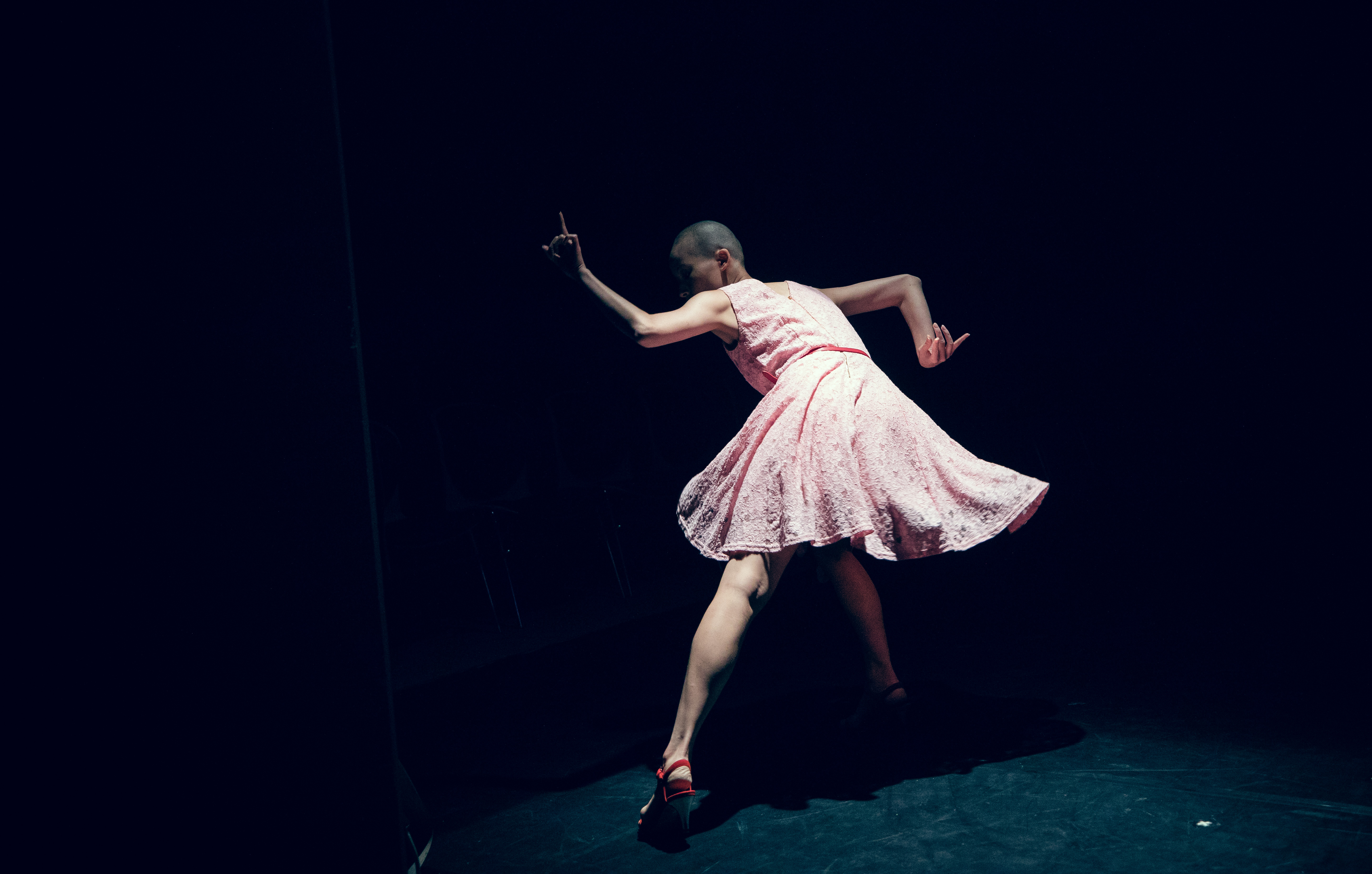更,是時間,是經歷,是改變,也是比較級……人生中面對考驗當下所做出的選擇,也許在事後會有著不同的想法,於是若再遇上類似情況時就會調整方式與心態,這便是成長。《更》即是以這樣的思維而成,企圖挑戰人對於「好」的定義以及忠實呈現出那些當下的情緒。
作品中,燈光自始至終都扮演著賦予考驗的神秘角色,表演者在明與暗之間求生存;無論是平靜重複的單音、寂靜無聲或是抒情歌曲,音樂成為作品中情緒表達極為重要的管道,例如劉奕伶首度嘗試作詞的 It’s Not About You,以嘻哈說唱作為遇到考驗時的發洩。而日本拔刀術居合道十二式,是整支獨舞的主動作發想來源,全長約22分鐘的作品,僅以此套2分鐘的動作來做出變化,在重複的路徑中以及上下舞台邊緣相互對照的環境裡,製造出相異的人物狀態。
Geng represents time, experience, change, as well as a comparison by degree. There may be choices made in a time of crisis in life that one would rethink after the fact; if method and mindset is adjusted when a similar situation is encountered again. This represents growth. GENG took shape under this line of thought, an attempt to challenge how “good” is defined and to faithfully present the emotions in that moment.
Throughout the work, lighting plays a role of mystery and challenge. The performer strives for survival between the light and darkness. Music becomes an extremely important conduit for expression in the work, whether it’s a single, calm repetitive note, complete silence, or an expressive love song. For instance, LIU I-Ling’s first foray at lyric writing, It’s Not About you, uses hip-hop to release tension when obstacles are encountered. The 12 standing techniques of Japanese battōjutsu Iaido serve as a source of inspiration for the main movements in the solo dance performance. The work, lasting 22 minutes, comprises of variations on these two minutes of movement. Different character states are created in the process of repetition and in the corresponding environment on and off the stage.
劉奕伶 LIU I-Ling
旅居美國紐約,現為美國比爾提瓊斯/阿尼贊舞團Bill T. Jones/Arnie Zane Company 資深舞者。2012年曾擔任北藝大焦點舞團《D-Man in the Waters》排練指導。2014年回台參與驫舞劇場創團十年製作,於國家戲劇院演出陳武康《裝死》。2015年起擔任 BTJ / AZ 團內舞者自製演出 Dances by Dancers 製作人,同年參與何曉玫Meimage Dance「鈕扣計劃」發表個人創作《噓》,並於2017年夏天再度回歸發表新作《更》。
Currently residing in New York, LIU I-Ling is a senior dancer at the Bill T. Jones/Arnie Zane (BTJ/AZ ) Company. In 2012, she served as Taipei National University of the Arts Focus Dance Company rehearsal master for D-Man in the Waters. She returned to Taiwan in 2014 to participate in a performance of CHEN Wu-Kang’s Play Dead at the National Theater produced on the tenth anniversary of HORSE dance theater. She took on a producer role for the self-choreographed Dances by Dancers at BTJ/AZ in 2015, as well as a performance of her own work entitled Shush in Hsiao-Mei HO’s Meimage Dance New Choreographer Project. She returned in 2017 to perform her new work, GENG.
劉奕伶
劉奕伶
Antonio Brown
Christina Robson
張玹
劉家明
野墨坊
華山1914文化創意產業園區 烏梅劇場
關鍵字
藝術家談作品
更,是時間,是經歷,是改變,也是比較級……
2015年,劉奕伶第一次參與何曉玫Meimage Dance「鈕扣計劃」,發表個人創作《噓》,探討的是「放不下」這件事;兩年後的夏天,劉奕伶再度回歸「鈕扣計劃」,這次她問自己「什麼是心裡還存在的東西」?她在紙上寫了各種答案,發現寫得最多的是「更」這個字,更好、更棒、更舒服……於是,劉奕伶以《更》為主題,企圖挑戰人們對「好」的定義,並忠實呈現人們在追求完美時的情緒狀態。
面對考驗時的心情與改變
更,是時間,是經歷,是改變,也是比較級……
劉奕伶認為,人生中面對考驗當下所做出的選擇,也許在事後會有著不同的想法,若再遇上類似情況時,就會調整方式與心態,這便是成長。《更》即是以這樣的思維出發的作品。
在舞作中,音樂成為情緒表達極為重要的管道,劉奕伶首度嘗試作詞《 It’s Not About You》,將自己遇到考驗時的生氣、後悔,以及不知所措的心情,以嘻哈說唱的方式作為發洩;《Long 20 6》的節錄版本,聽似平靜重複的單音,卻充滿了疑惑與思考;而在沒有任何聲音的段落,雖然增加了表演者的恐懼,卻也豐富了她的勇氣;《最好的祝福》則貫穿全場,表演者從一開始便企圖演唱此曲,卻屢受阻礙,中間曾以哼唱此曲來掩飾緊張,而在舞作最後所播放的完整版本,則讓表演者的脆弱表露無疑。
日本拔刀術居合道十二式融入舞作
劉奕伶說,或許是因為旅居國外,常因為語言關係而吃虧,心中的不安全感也往往影響了情緒。「能夠即時反應是很重要的!」有趣的是,她把這種自我防衛的心理狀態也融入舞作中,而且使用的元素是——日本拔刀術居合道十二式。
日本拔刀術居合道十二式講求「一擊必殺」,以假想敵人來襲時的各種迅速應對方式而制定出的一套武道修煉,是整支獨舞的主動作發想來源。此套武術動作全長僅僅2分鐘,劉奕伶延伸成為22分鐘的作品,有些動作轉化為簡單的手勢,有些動作則改變方向和質感,在重複的路徑中以及上下舞台邊緣相互對照的環境裡,製造出相異的人物狀態。
燈光扮演試煉者的角色
《更》主要以六小段落架構而成,各段落之間利用服飾的更換作為角色狀態的不同。除了音樂和武術之外,燈光自始至終都扮演著試煉者的神秘角色,總是不著痕跡地觀察,允許一切發展的空間,再尋找時機點超乎意料地出招,象徵難以預料的人生,也就像是「老天爺的安排」。
「這支舞的燈光有50個Cue點,平均每一分鐘就要換一次。」劉奕伶笑道,所以她總是對燈光設計說:「大哥,你就是我的老天爺!」而表演者在燈光的明與暗之間求生存,有時看似擁有光亮的外表,但也許根本不夠資格承擔過多的注視,有時自認萬事俱備,卻唯獨欠缺燈光的眷顧,過程有埋怨、自卑、不甘心,但還是可以繼續努力。
劉奕伶說,這些過程其實都反映著她這兩年的心情。例如在最後一段〈刀山)中,她在舞台邊緣遊走,和觀眾之間的距離拉到最近,舞台燈光呈現一條細直的長線,而表演者踮著腳尖試圖平衡,就像走在刀山一般步步為營,不慎跌落燈外便重來,即便脆弱,也不言棄,伴隨著抒情歌曲邀請觀眾「一起成為更好的人呦~」。
如果2015年的《噓》,以不斷掙扎的「捨」、「去」,宣告出理想的自我期望;那麼2017年的《更》則關注在「取」、「留」,是描述對現狀無論順逆的自在。劉奕伶並不刻意展現完美雕琢成的肢體技巧,而是強調因為投入情境中而產生自然真實的身體直覺反應,透過這一路下來各種不同狀態與情緒的表演方式,能夠在不同時刻觸及觀眾的內心也引發其情緒,進而能時時坦然接受現況。人生,不就是如此嗎?
評審談作品
在三個不同的段落裡,舞者在權力的支配下先是不斷被否定、繼而嘗試逃脫遊戲、旋而積極對抗。舞作營造著一個不甘被操縱、不甘心妥協的少女形象。
入圍理由
在三段式的《更》中,劉奕伶以文學性的思考賦予聚光燈某種權力的象徵。在三個不同的段落裡,舞者在權力的支配下先是不斷被否定、繼而嘗試逃脫遊戲、旋而積極對抗。舞作營造著一個不甘被操縱、不甘心妥協的少女形象。她看似纖細而又鬆弛的肢體蘊藏著極大的爆發力與速度感,精細、機敏而不失幽默地重新詮釋了後現代主義舞蹈關於解構與釋放(release)技巧的含義。(主筆/張曉雄)
Comments on the finalist artworks
In this syllogistic work, GENG, LIU I-Ling adopts a writer’s way of thinking and transforms the limelight into a symbol of power. In the three sections, the dancer was first continuously denied by the power; then, she attempted to escape from the power play, and finally, became active in fighting against the power. The dance created the image of a young girl who was not willing to be manipulated and compromised. Her seemingly thin and relaxed gestures, in fact, manifested an extremely powerful force and speed. In a delicate, witty and somewhat humorous way, the work offers a re-interpretation of postmodern dance as well as its discourse on deconstruction and release techniques.(Commentator: ZHANG Xiao-Xiong)







